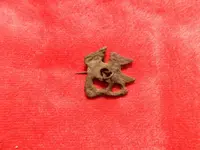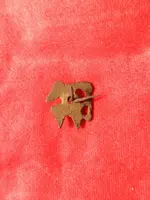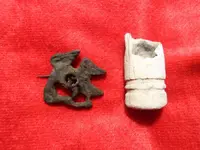Devonrex
Sr. Member
- Joined
- Jan 6, 2012
- Messages
- 351
- Reaction score
- 1,260
- Golden Thread
- 4
- Location
- SE Virginia
- 🥇 Banner finds
- 4
- Detector(s) used
- XP DEUS, Nautilus DMC IIB
- Primary Interest:
- Metal Detecting
| Devonrex[ PM ] Got a possible ID on the hat badge resembling a pelican I dug recently........ November 02, 2012 11:15PM |
[TD="class: message-user-info"]Registered: 5 years ago
Posts: 65
[/TD]
« on: Today at 10:24:00 PM »
--------------------------------------------------------------------------------
If you recall I recently dug this hat pin. Butch Holcombe of American Digger forwarded a picture of it to both Charlie Harris and Mike O'Donell. These are the responces I got back from both of them. Here is Mike O'Donnells take on it.
Butch Holcombe, Publisher
American Digger Magazine
American Digger the best historical, metal detecting and relic hunting magazine in print!
From: mike@
Sent: Friday, November 02, 2012 12:24 PM
To: Publisher
Subject: Re: Some recent finds
Yes, I believe it was an early cockade eagle. Probably French, circa 1790-1805. I think the earliest American cockade eagles were inspired by this design. They were also shown from the side and some of our eagles had similar heads. By the way, it is an eagle and not a pelican so a Louisiana connection is out. It is a thin casting, not die-struck which became more common with insignia made after 1810. The big hole in the center was apparently provided so the owner could sew it or use wire to affix it to the cloth cockade. This was not an unusual method of attachment during the late 18th century when soldered hooks and pins were seldom seen. Government surplus and obsolete Army equipment was auctioned off to the public. Contemporary entrepreneurs like Bannerman 100 years later would buy things like this insignia for next to nothing and make a profit selling it to the American market. In summary, it was first worn by a French soldier, then by an American militiaman, and now it is your forevermore. One heck of a cool find!
Mike
And this is what Charlie Harris said about it...................
« Reply #2 on: Today at 10:49:40 PM »
-----------------------------------------------------------------------------
Hi John,
I wish that I could add more to the identity of this piece, but I cannot find anything similar in any of my references either. Looking through Albert's button book, I did notice that LA1 does have a slight resemblance to your pin. Just very slightly.
I'm also fascinated by the attachment pin. It looks very muck like a cotter pin that has been adapted for its use for attachment. The hole that it is using for attachment also looks to be "after market" & drilled at a later date.
The bird does definitely have the Pelican feeding its young look to it, even though there are no young with it.
Also after looking through O'Donnell & Duncan's book, American Military Headgear Insignia, I also get a gut feeling that it is somewhat similar to the Cockade Eagles of the 1795 to 1815 era. The structure, shape and feel of the image just give me that deep down feeling of similarity. It may very well be a state hat pin that was produced during this period and so far, just not recorded in any of the books. The size even falls within the Cockade Eagle boundaries. I just cannot prove my feelings.
Keep your powder dry,
Charlie Harris
Since I found this piece near Yorktown, Virginia I know for a fact both French and American soldiers were encamped in this area. Both experts agree this piece could be late 18th century. I'm beginning to wonder if maybe this pin was worn by a French soldier back in 1781 and lost. This area saw heavy military action during the Rev War and the Peninsula Campaign of the Civil War. Their was really little military action in between. Because of this I honestly believe this was a pin worn by a member of Rochambeaus Army and is a Revolutionary War artifact. Regardless I am very happy to find an artifact that hasn't been published in any book. Devonrex
Edited 1 time(s). Last edit at 11/02/2012 11:16PM by Devonrex
Attachments
Last edited:
Upvote
0




